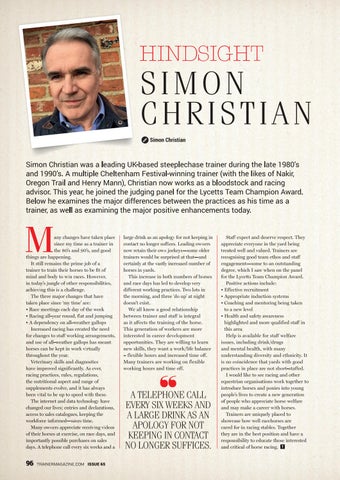SIMON CHRISTIAN Simon Christian
Simon Christian was a leading UK-based steeplechase trainer during the late 1980’s and 1990’s. A multiple Cheltenham Festival-winning trainer (with the likes of Nakir, Oregon Trail and Henry Mann), Christian now works as a bloodstock and racing advisor. This year, he joined the judging panel for the Lycetts Team Champion Award. Below he examines the major differences between the practices as his time as a trainer, as well as examining the major positive enhancements today.
M
any changes have taken place since my time as a trainer in the 80’s and 90’s, and good things are happening. It still remains the prime job of a trainer to train their horses to be fi fit of fit mind and body to wi win races. However, win in today’s jungle of other responsibilities, achievi ving this is a challenge. vin The three major changes that have taken place since ‘my time’ are: • Race meetings each day of the week • Racing all-year round, fl flat and jumping fla • A dependency on all-weather gallops Increased racing has created the need for changes to staff ff working arrangements, and use of all-weather gallops has meant horses can be kept in work vir irtually throughout the year. Veterinary skills and diagnostics have improved signifi ficantly. As ever, fic racing practices, rules, regulations, the nutritional aspect and range of supplements evolve, and it has always been vit ital to be up to speed wi with these. wit The internet and data technology gy have changed our lives; entries and declarations, access to sales catalogues, keeping the workforce informed—saves time. Many own neers appreciate receivin ing vi videos vid of their horses at exercise, on race days, and importantly possible purchases on sales days. A telephone call every six weeks and a
96
TRAINERMAGAZINE.COM ISSUE 65
large drink as an apology for not keeping in contact no longer suff ffiicces. Leading own ffi wners wne now retain their own wn jockeys—some older trainers would be surprised at that—and certainly at the vastly increased number of horses in yards. This increase in both numbers of horses and race days has led to develop very diffe ferent working practices. Two lots in the morning, and three ‘do up’ at night doesn’t exist. We all know a good relationship between trainer and staff ff is integral as it aff ffects the training of the horse. ffe T h i s g e n e r a t i o n o f w o r ke r s a r e m o r e interes ted in career de velopment oppor tunities. T he y are willin g to learn ne w skills, the y want a work/life balance – fl flexible hours and increased time off fle ff. ff. Many trainers are working on fl fl e x i b l e fle working hours and time off ff. ff.
A TELEPHONE CALL EVERY SIX WEEKS AND A LARGE DRINK AS AN APOLOGY FOR NOT KEEPING IN CONTACT NO LONGER SUFFICES.
Staff ff expect and deserve respect. They appreciate everyone in the yard being treated well and valued. Trainers are recognising good team ethos and staff ff engagement—some to an outstanding degree, which I saw when on the panel for the Lycetts Team Champion Award. Positive actions include: • Eff ffective recruitment ffe • Appropriate induction systems • Coaching and mentoring being taken to a new level • Health and safety awareness highlighted and more qualifi fied staff fie ff in this area Help is available for staff ff welfare issues, including drink/drugs a n d m e n t a l h e a l t h , w i t h m a ny understanding diversity and ethnicity. It i s n o c o i n c i d e n c e t h at y a r d s w i t h go o d practices in place are not short-staff ffed. ffe I would like to see racing and other equestrian organisations work together to introduce horses and ponies into young people’s lives to create a new generation of people who appreciate horse welfare and may make a career wiitth horses. Trainers are uniquely placed to showcase how well racehorses are cared for in racing stables. Together they are in the best position and have a responsibility to educate those interested and critical of horse racing.
